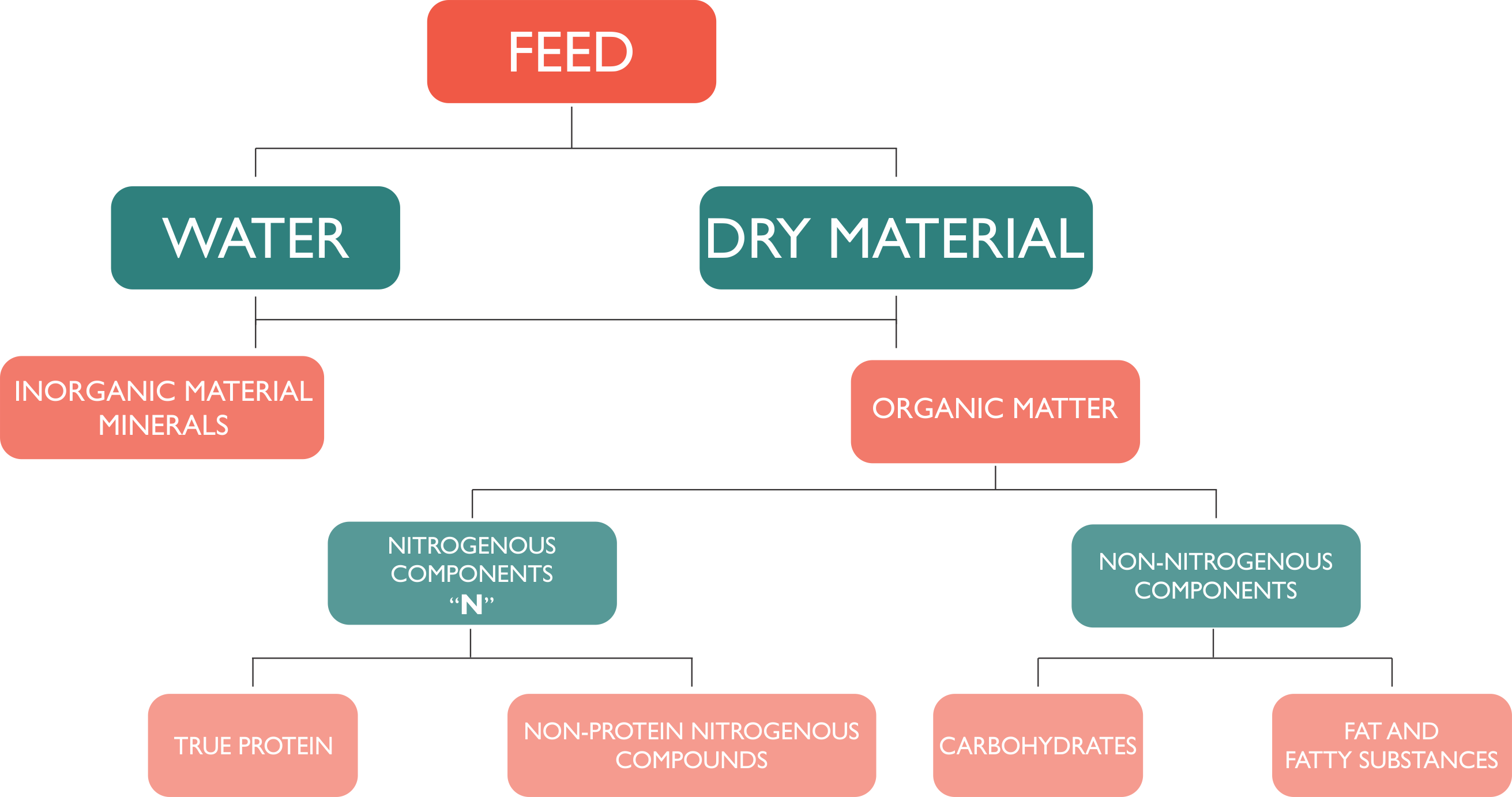Most livestock species are herbivores, so plants are their exclusive source of nutrition under natural conditions (though some commercial feed supplements may contain animal by-products, such as blood meal, dried whey or meat and bone meal). Pigs and poultry are an exception to the rule – like humans, they’re omnivores and at least a portion of their natural diet is composed of animal mater (which includes insects!)

Click here to view a video that explains the composition of animal feed.
Carbohydrates
Carbohydrates form about three-fourths of the dry matter in plants, so they are the most significant component of feed. The carbohydrate group can be broken down into sugars, starches and fibre; the proportion of each varies according to the plant’s age, environmental factors and the type of plant.
Starches are composed of groups of sugar molecules strung together. All animals easily digest both sugars and starches, so they provide a relatively high feed value. On the other hand, the fibre component is made up primarily of lignin’s and cellulose. The lignins are completely indigestible and the cellulose, which accounts for about 50 percent of the organic carbon on earth, requires bacterial fermentation to break it down into usable sugars and starches. All animals are able to ferment a small amount of cellulose in their intestines, but only the ruminants, such as cattle and sheep, are able to convert the bulk of the cellulose in their diet into usable sugars and starches.
Click here to view a video that explains the role of carbohydrates in living organisms/animal feed.
Fats and Fatty Substances
Like carbohydrates, fats and fatty substances are made up of carbon (C), hydrogen (H) and oxygen (O); however, the proportions of carbon and hydrogen are much greater than that of oxygen in fat. Despite our current fear of fat, it is an essential nutrient for all animals (especially young animals), including humans. Fat provides more than twice the energy that carbohydrate provides, and it helps an animal maintain its body condition and temperature.
Click here to view a video that explains the role of fats and fatty substances in cow nutrition.
Protein
Proteins are essential for the development of all cell walls. They are also critical for forming muscles, internal organs, blood cells, hair, horns and bones. In most animals, protein accounts for 15 – 20 percent of the animal’s weight.
Unlike simple sugars, which may contain as few as 20 atoms each molecule of protein is made up of thousands of atoms. In the case of proteins, the building blocks nature has developed to simplify construction are called amino acids. There are many thousands of amino acids, but only about twenty are critical for protein construction.
Click here to view a video that explains the role of protein in dairy cow nutrition.
Vitamins
Vitamins are organic in nature (they burn off in the laboratory sample with other organic matter), but unlike carbohydrates, fats, and proteins, there is no rhyme or reason to their structure: Each one is unique from the others in its chemical formulation.
Vitamins are required in very small quantities, but deficiencies of vitamins in the diet can result in a wide range of diseases, including rickets, anaemia, and muscular dystrophy. At the same time, some vitamins, such as vitamin A, can be toxic if given in too high a quantity. Vitamin D deficiency is common in animals that are reared completely indoors; however, animals that spend at least some time regularly in the sun don’t have this problem, because Vitamin D is synthesized by the body when exposed to sunlight.
Click here to view a video that explains mineral injection for cattle.
Minerals
The mineral, or ash, component of feed is what remains after the laboratory fires the feed sample at a high temperature. Like vitamins, most of the minerals aren’t required in very large quantities, but deficiencies cause a wide range of health problems, and toxicity can occur when there are mineral excesses in the diet. The minerals include such elements as sodium, calcium, phosphorus, and selenium.
Mineral deficiencies (or excesses) usually occur where soil mineral imbalances exist. Plants that are grown in soil that is either too low or too high in any given mineral will reflect the soil imbalance in their tissue. The best way to learn about soil mineral levels on your farm is to have soil and forage samples run. Check with your local County Extension Agent, a reputable feed dealer, or your veterinarian for information on the general status of soil mineralization in your area. They can help you evaluate what types of mineral supplements will be best for your situation (your animals, your soil, and so on).
Mineral supplements are best-fed free-choice. Animals are really quite efficient at controlling their intake of mineral supplements in order to meet their own needs. The best approach is to always have a free-choice plain white salt block and a free-choice trace-mineral block available. Another excellent source of vitamins and minerals that we put out is kelp meal. This dried sea plant provides a smorgasbord of vitamins, minerals and amino acids that all animals seem to love.
Click here to view a video that explains mineral supplements for beef cattle.